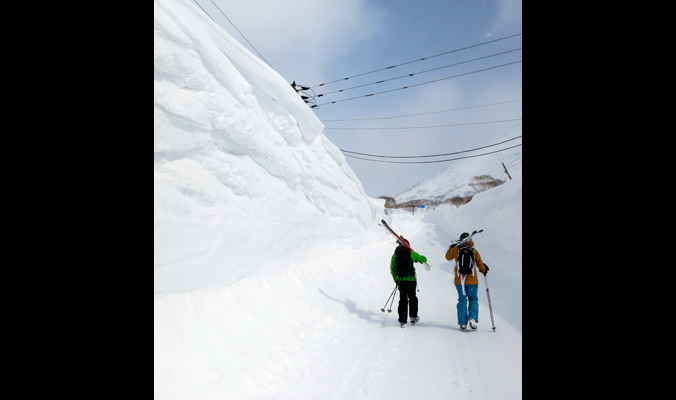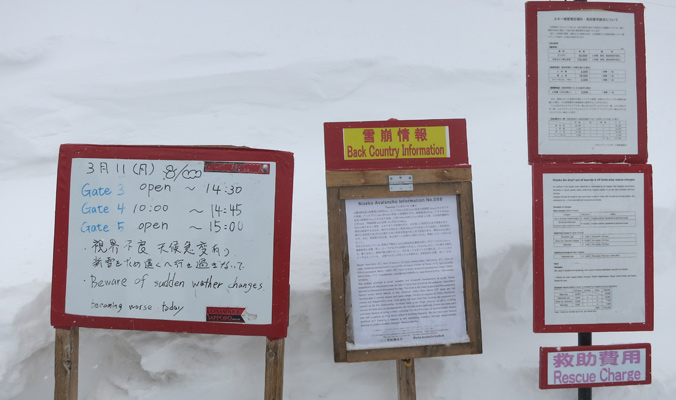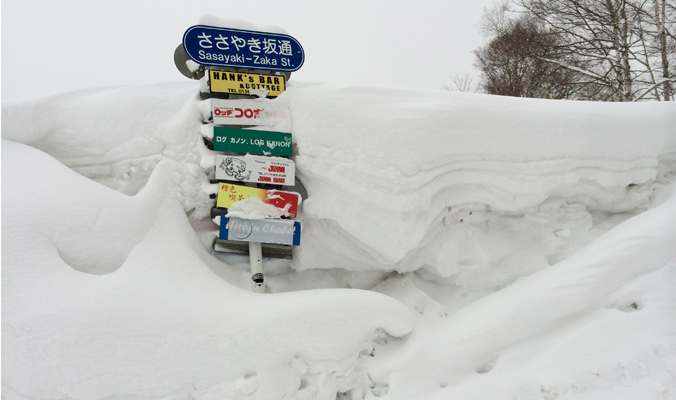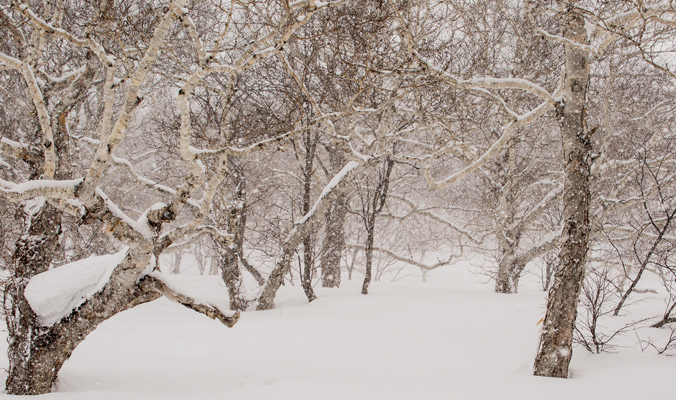Snow whipped across the summit ridge of Mt. Niseko An’nupuri, the 1,308-meter peak above Niseko, Japan’s Grand Hirafu resort. Hooded and with my head down, I felt trapped in a claustrophobia-inducing vision field of white, surrounded by skiers and riders swarming for the summit. Even though it had snowed more than a meter in the last two days, this crowded, windy and cold place wasn’t the Japan I’d seen in pictures and videos, lush with gnarled birches piled in meters of snow. But the snow blowing across the bootpack was landing somewhere.
At the flat, whitewashed peak, Donny McFarlane, a dreadlocked backcountry guide with the Niseko Outdoor Adventure Sports Club (NOASC), led the way into North Bowl, off the backside of the resort. “Enjoy lads,” an Aussie snowboarder said as we dropped into 1,000 feet chunky, wind-swept powder before traversing for another 1,000 vertical feet westward. At the bottom of the vast and white north-south valley, we stopped at a road that dead-ended in a 15-foot wall of snow.
Everything was quiet and calm. Beside the road to nowhere, Goshiki Onsen spewed steam into the still air (an onsen is a natural hot spring). A birch-and pillow-filled bowl rose above the sulfurous pools to a sinuous ridgeline. This was the Japan I’d heard about, the dream-like snow globe that receives some 14 meters of snow annually, stirring the collective consciousness of backcountry skiers and calling them east.
On our climb, Donny mentioned it wasn’t just the quantity of snow that drew skiers and riders here, but the reliability. Plane tickets from the U.S. cost upward of $1,500, but, according to him, you’re virtually guaranteed snow in January or February. “Look at the forecast and add a zero after the expected snowfall,” he said, breaking trail through knee-deep fresh.
When I returned from that late-morning tour, I asked Ross Carty, Donny’s boss and the owner of NOASC, if that’s been his experience, too. Carty, an Aussie, has spent 25 years in Niseko and hasn’t seen one sub-par winter. “Every year we just get snow,” he said. “I’ve never seen less than a meter and a half on the ground.”
He’s also noticed an uptick in traffic, and the number of backcountry tours his company guides has nearly doubled in the last half-dozen years. That growth, Carty said, corresponds to Niseko’s backcountry safety maturation. Akio Shinya, a lodge owner in Moiwa, began formally reporting on the region’s avalanche conditions in 2007, and the Niseko resorts introduced backcountry gates around that same time.
That’s when Washington-based photographer Grant Gunderson first traveled to Japan. I reached out to Grant when I returned home to see what first drew him there. “Stories of amazingly deep pow,” he said without hesitation. “I’ve gone every January since, and I’ll go every January for the rest of my life.” In seven years, Gunderson estimates he’s published more than 500 images from Japan—including about 25 magazine covers.
 Though he’s in the business of selling deep powder images, he’s quick to point out the cultural relevancy of any trip to Asia, too. “I think it’s one of the few places where you’ll really get a large culture shock that you won’t get in Europe or South America,” he said. “It’s the one place that, heaven forbid, if we got skunked the entire time, I honestly wouldn’t care because of the culture.”
Though he’s in the business of selling deep powder images, he’s quick to point out the cultural relevancy of any trip to Asia, too. “I think it’s one of the few places where you’ll really get a large culture shock that you won’t get in Europe or South America,” he said. “It’s the one place that, heaven forbid, if we got skunked the entire time, I honestly wouldn’t care because of the culture.”
Photographer Garrett Grove agrees, mentioning the openly friendly people, intricate, sometimes bizarre food and the onsen experience even before bringing up snow. And while, like Gunderson, he hails from the powder-rich Northwest, he’s willing to skip a month at home for Japan. “January is a pretty high-pressure month in Washington,” Grove said, “and in three or more decades, [I can think of] one or two Januarys that have really been stormy.” So two years back, he bought a ticket for three weeks of nearly guaranteed powder abroad. Last season, he went back for almost two months.
Jonah Howell, co-creator Powderwhore Productions made the same decision last season seeking out deep snow for their 10th-anniversary film, Some Thing Else, during a sub-par Wasatch winter. “It just hadn’t been snowing, and the Wasatch has always been our go-to pow segment,” he said. “We really got, if not equal to the best, the best pow we’ve ever shot.”
Gunderson thinks that, even as weather gets weird in other parts of the world, it will always snow—and snow a lot—in Japan, given its unique location that combines a polar jet stream off Siberia and immediate seaside elevation. “Japan is always going to be a pretty consistent spot,” he said. “I mean, unless the jet stream completely stops, you’re going to have powder in Japan.”
Beyond the culture, snow quantity and reliability, Howell, Gunderson and Grove all point to one reason for Japan’s current rise to backcountry-skiing prominence: accessibility.
“It’s not all big, huge Alaskan faces or crazy couloirs [like] in the Alps. It’s tree skiing, for the most part, and it’s really user accessible,” Grove said. “So I think most people see all the photos and are like, ‘I can picture myself doing that.’” Gunderson agrees, adding that more skiers and riders than ever are backcountry savvy and have the skills—and gear—to ski deep snow. “Most of the time you’re dealing with a stable snowpack,” Howell added.
They’re all correct, except for one unexpected hazard. The biggest crux of that ski tour with Donny came after slicing smooth powder through snow-obscured sunlight in the bowl above Goshiki Onsen. We walked back to the dead-end and scaled the hulking snow bank to find ourselves some 20 feet above the road. Telephone poles poked from the snow and, between them, power lines drooped into the powder like a sagging electric fence. But one careful step over the finger-thick, black wires—and a half-hour skin back inbounds—was all that separated me from a noodle-bowl and sushi lunch.
This story first appeared in the September 2014 issue.


















NAIIGATA…×
Myoko is in 《NIIGATA》pref.
And hakkoda (aomori pref.,located in the north end of honshu-island) Is very nice place to ski.
Nozawa Onsen is a fabulous place, formerly hosting part of Japan’s winter olympics
The village of nozawa onsen has created more winter olympians than any ither village in japan
We get a consistent 14 metres of perfect powder at our front door every year !